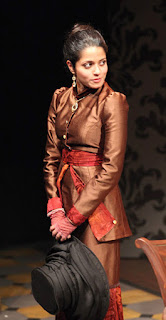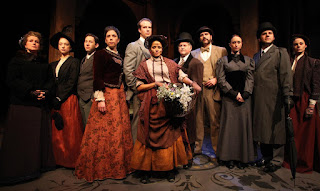In our continuing series of posts looking behind-the scenes at BoHo's co-production of Pygmalion with Stage Left Theatre, we sat down with long-time BoHo Costume Designer Theresa Ham to discuss how she approached her work for this show.
Theresa: Designing Pygmalion was a big challenge, not only to create a beautiful full world, but working with the artistic visions of two companies. I have worked with BoHo for eight years, so I feel like I have a good grip on the artistic ideals for that company. But adding in Stage Left Theatre's artistic director Vance Smith, brought a new voice to my work with the company. I am always excited to work with new people, and this experience has been really great!

How to you get started when you are putting together costumes for a show? What's your first step?
My first step is always to make a list of needs for the show. For example, what are the must haves that are referenced in the script and then discuss how to create the overall look with the director, in this case Vance Smith. Once I have a list of needs and a visual direction, I either draw, do research, or begin pulling items from stock sources.
Where do you find your inspiration in general? What about your inspiration for Pygmalion?
Theresa:I think inspiration can come from anywhere! As an artist, I am influenced by everything: fashion, studio art, nature, history, ect. Pygmalion is a period piece, meaning it is rooted in a past era, so when I have a project like this, the first place I look for inspiration is fashion books that illustrate the style of clothing during the given period— in this case, 1905-1912. From there, I can decide color and fabric to create a complete look.

What do you find to be the most fun aspect of designing costumes for the stage, especially a period piece like this?
Theresa:The most fun is recreating the style of the period: really getting into how each character would present themselves given the style of the time. I really love watching actors get dressed in period costumes. It always effects their posture, demeanor, and movement. I think it helps them feel more appropriate, and it always makes me feel good to have the costumes make a positive impact on the actors.
What is the most challenging aspect about what you do?
I think my biggest challenge is to get inside each character. As an actor, you really have to know the character you are portraying, but as a costumer, you are making choices about every character in the play. I have to know how each character fits in the social ladder of the piece, how they view themselves, how their inner emotions might effect their clothing choices, and then how to convey that knowledge through costume to the audience! It's a big task, and I often rely on the director and actors to help me make those tough choices.

What is something that you think people don't realize about your craft?
It is extremely collaborative. I work with everyone involved in the production. My work begins with the director, but I also need to communicate with the scenic designer (who creates the environment), lighting designer (who creates the emotional environment), actors (who actually wear the clothes), producers (funding and artistic vision), stage mangers and crew persons (who give our show continuity and make sure it can actually all work together backstage). If I am unwilling to collaborate and work together with others, my work will never be as good as it could be, because all of these people are inherently a part of it.

See Theresa's beautiful costumes in action: Pygmalion is currently running at Theater Wit through February 10th. Learn more...




No comments :
Post a Comment